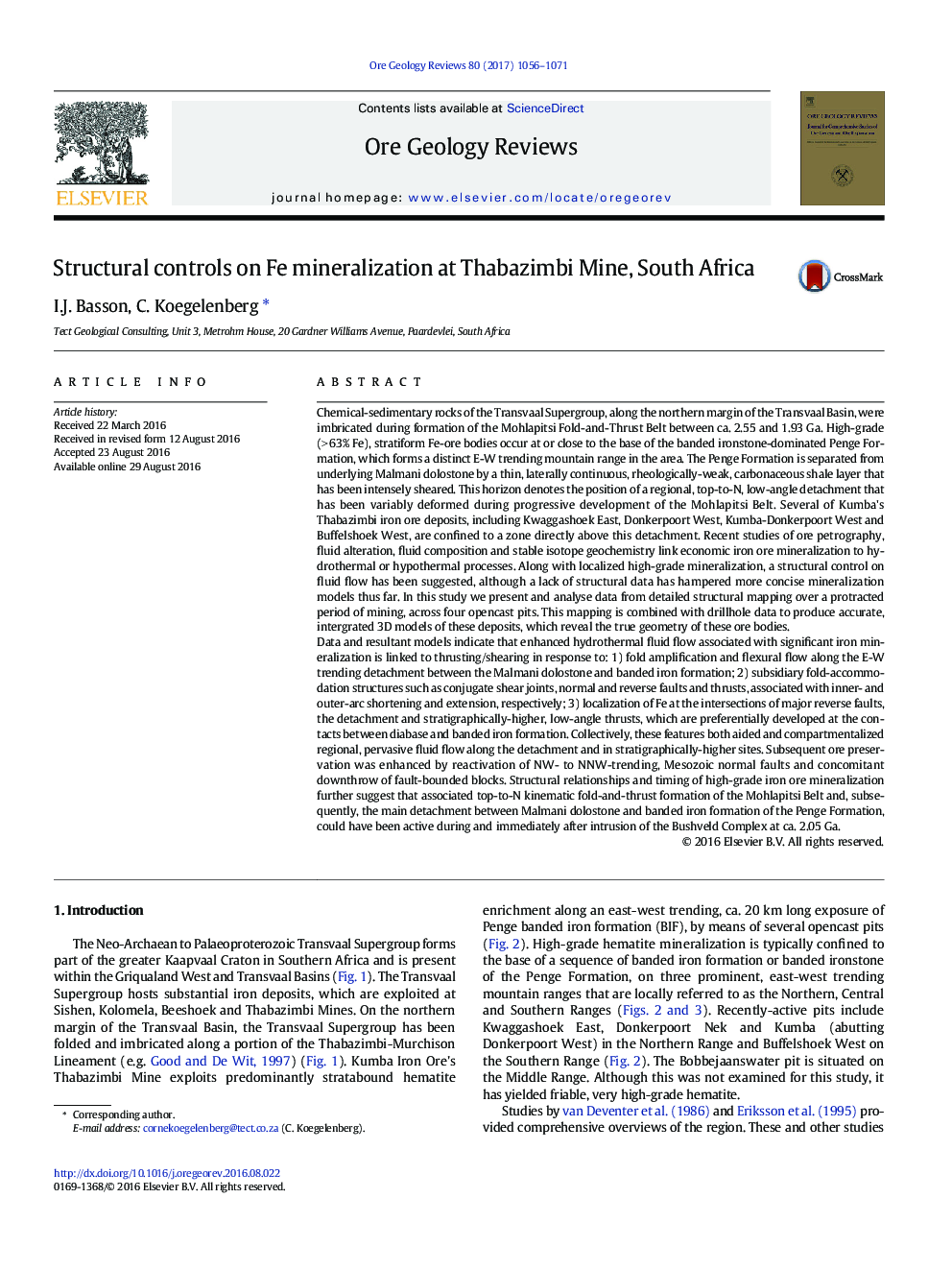| کد مقاله | کد نشریه | سال انتشار | مقاله انگلیسی | نسخه تمام متن |
|---|---|---|---|---|
| 6435684 | 1637226 | 2017 | 16 صفحه PDF | دانلود رایگان |

- Detailed structural analysis and 3D modelling of Thabazimbi Mine deposits
- Description of primary D2 fold-and-thrust development and fluid flow during Mohlapitsi Belt development
- Syn-D2 hydrothermal hematite mineralization localized along intersections of transposed detachment and reverse faults.
- Timing of mineralization and tectono-thermal activity is possibly related to emplacement of the Bushveld Complex.
Chemical-sedimentary rocks of the Transvaal Supergroup, along the northern margin of the Transvaal Basin, were imbricated during formation of the Mohlapitsi Fold-and-Thrust Belt between ca. 2.55 and 1.93Â Ga. High-grade (>Â 63% Fe), stratiform Fe-ore bodies occur at or close to the base of the banded ironstone-dominated Penge Formation, which forms a distinct E-W trending mountain range in the area. The Penge Formation is separated from underlying Malmani dolostone by a thin, laterally continuous, rheologically-weak, carbonaceous shale layer that has been intensely sheared. This horizon denotes the position of a regional, top-to-N, low-angle detachment that has been variably deformed during progressive development of the Mohlapitsi Belt. Several of Kumba's Thabazimbi iron ore deposits, including Kwaggashoek East, Donkerpoort West, Kumba-Donkerpoort West and Buffelshoek West, are confined to a zone directly above this detachment. Recent studies of ore petrography, fluid alteration, fluid composition and stable isotope geochemistry link economic iron ore mineralization to hydrothermal or hypothermal processes. Along with localized high-grade mineralization, a structural control on fluid flow has been suggested, although a lack of structural data has hampered more concise mineralization models thus far. In this study we present and analyse data from detailed structural mapping over a protracted period of mining, across four opencast pits. This mapping is combined with drillhole data to produce accurate, intergrated 3D models of these deposits, which reveal the true geometry of these ore bodies.Data and resultant models indicate that enhanced hydrothermal fluid flow associated with significant iron mineralization is linked to thrusting/shearing in response to: 1) fold amplification and flexural flow along the E-W trending detachment between the Malmani dolostone and banded iron formation; 2) subsidiary fold-accommodation structures such as conjugate shear joints, normal and reverse faults and thrusts, associated with inner- and outer-arc shortening and extension, respectively; 3) localization of Fe at the intersections of major reverse faults, the detachment and stratigraphically-higher, low-angle thrusts, which are preferentially developed at the contacts between diabase and banded iron formation. Collectively, these features both aided and compartmentalized regional, pervasive fluid flow along the detachment and in stratigraphically-higher sites. Subsequent ore preservation was enhanced by reactivation of NW- to NNW-trending, Mesozoic normal faults and concomitant downthrow of fault-bounded blocks. Structural relationships and timing of high-grade iron ore mineralization further suggest that associated top-to-N kinematic fold-and-thrust formation of the Mohlapitsi Belt and, subsequently, the main detachment between Malmani dolostone and banded iron formation of the Penge Formation, could have been active during and immediately after intrusion of the Bushveld Complex at ca. 2.05Â Ga.
Modified local lithostratigraphy and structure of the Thabazimbi mine district after Boardmann (1948) and data generated from this study. Stereonet projections are set to lower hemisphere and equal area. BC - Bushveld Complex; WB - Waterberg Group; DP - Daspoort Formation; HP - Hekpoort lavas (basaltic), TBH - Timeball Hill Formation; BIF - Banded Iron Formation. Diabase and inferred dolerite ages from Chisonga (2012), and BC from Walraven (1997).
Journal: Ore Geology Reviews - Volume 80, January 2017, Pages 1056-1071